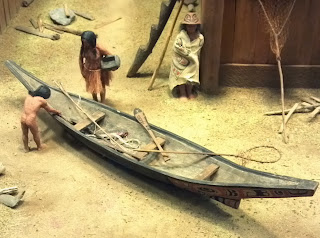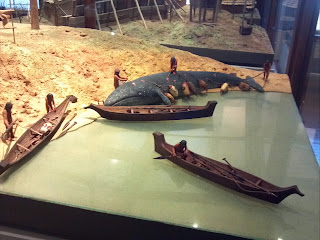Let's look at more maritime-related dioramas at Harvard University's Peabody Museum of Archaeology and Ethnology, these depicting cultures of the Pacific Northwest of North America. (Previous posts about the Peabody's exhibits include coverage of Baffinland Inuit, Aleuts and other Alaskan Eskimo.)
 |
| The Nuu-chah-nulth people, formerly known as the Nootka, traditionally lived on Vancouver Island, where whaling, as shown in this diorama, constituted one of their important economic activities. The aboveground house is entirely built of planks, with stones weighting down the roof planks. I don't know the purpose of the horizontal log raised on log uprights just to the right of the house. (Click any image to enlarge.) |
 |
| Moving on to another Pacific Northwest culture: the traditional home of the Haida people was coastal northern British Columbia and southern Alaska. The basic canoe-building process was the same as that of the Nuu-chah-nulth, but the boats exhibit striking differences. Most notable is the forward skeg: the boat's bow is to the right, and what appears to be a conventional stern skeg is actually a kind of cutwater. This is a fishing canoe. In the stern is what appears to be a leister, a fish spear whose head has a central point on which the fish is impaled, and two prongs on either side that prevent it from escaping. In the bow is a long-handled dip net. The decorated paddles have broad, rounded blades somewhat like beavertails, and a grip reminiscent of the Maine Northwoods style. The woman immediately behind the canoe holds a box that appears to be carved from a solid block of wood. The person to her left wears a bentwood hat. |
 |
| The traditional range of the Kwakwa̱ka̱’wakw people (formerly and incorrectly known as the Kwakiutl, who were actually just one of the tribes of the Kwakwa̱ka̱’wakw culture) was northern Vancouver Island and the nearby mainland and smaller islands. From the exhibit's display card: "As with most Northwest Coast tribes, Kwakiutl villages are found along the shoreline. This is because the sea traditionally furnished their principal foods, including various species of fish, sea mammals, and molluscs. A memorial pole stands before two permanent houses in this scene. Prior to the introduction of commercial lumber, the Kwakiutl made boards of split planks of red cedar. This wood was of particular importance to these Indians for many items of manufacture. The completed house has an elaborate design on its front which identifies the crests of the family. The framework for these houses consists of heavy beams and posts, all of which were carved and notched prior to raising. The roof boards are split so that their edges turn up. When placed on the rafter, the lower boards are set concave side up so that they serve as gutters. Heavy stones are set on one of these roofs as an added precaution to keep the planks from blowing off during inclement weather." |















Thanks for this series. The log on uprights could be for processing skins, maybe a little out of scale.
ReplyDeleteI have checked in the book The Hunting Peoples by Carleton S Coon, 1971. He gives a diagram of a Nootka whaleboat but this has a square transom with a notch for a steering oar and may show influence of European whalers.
The diagram shows harpoon lines and floats along with deflated floats. There are harpoons and paddles but no triangular wooden object even though their is a box on the bow for the harpooner's tackle.
I wonder though if the wooden triangle is a form of hydrofoil which is attached to the float line and adds to the difficulties of the prey in submerging.
The item in question is a bailer which is carved from a solid block of maple or alder. A more detailed description of this item can be seen in "The Whaling Equipment of the Makah Indians" T.T. Waterman, University of Washington, 1919, pp 27-28. This book is available online from various sources as a free download. Glad to help.
ReplyDelete